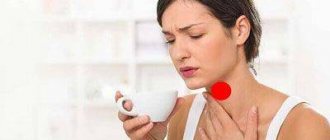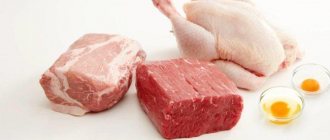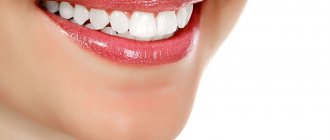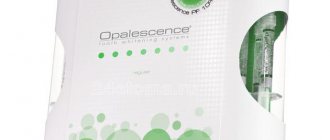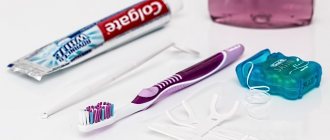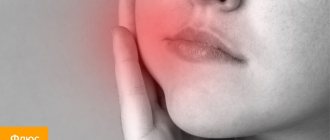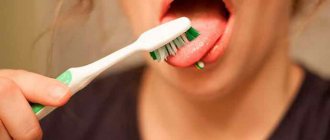Mechanical damage to a tooth due to injury without violating its integrity is called a bruise. This type of injury is common in children and adults, especially athletes. According to statistics, among all injuries to primary teeth, bruises account for 2.5%; bruises of permanent teeth account for 1.5% of the total number of traumatic injuries in the permanent dentition.
Even if the tooth looks unchanged after a bruise, it is necessary to visit a dentist to prevent the development of complications associated with the injury.
Symptoms
A strong blow to a tooth is accompanied by damage to periodontal tissue, and some fibers and small blood vessels rupture. There are no visible structural damage to the tooth; upon visual inspection, it appears intact. After a bruise, the tooth remains motionless, and minor mobility is rarely observed. The gums in the area of the injured tooth swell.
In the first hours after the impact, patients experience pain in the tooth, which intensifies when biting; the pain is aching in nature. The tooth feels high, and slight bleeding may occur from under the gum near it. When a bruise occurs, the neurovascular bundle of the tooth can be damaged, that is, the pulp is injured, and hemorrhage occurs in the pulp chamber, and the enamel becomes pink in color. A severe bruise can lead to the death of the pulp.
Often, when a bruise occurs, cracks appear on the tooth enamel, which can only be detected with a special examination.
Diagnostics
- Patients with a tooth injury are referred for x-ray diagnostics to exclude a root fracture. To obtain information using targeted radiography, it is sometimes necessary to take several images from different angles, which is undesirable for the patient.
The most accurate information about the condition of the roots is provided by computed tomography - an x-ray examination method that allows you to obtain a three-dimensional image of the tooth. The examination results are displayed on the computer screen and must be transferred to a CD or USB flash drive.
An X-ray examination of a tooth bruise reveals a slight widening of the periodontal fissure.
- The condition of the pulp after injury is monitored using EDI - electroodontodiagnosis. The method consists in determining the reaction of the nerve endings of the pulp to the influence of electric current. The level of electrical excitability of the pulp depends not only on its condition, but also on the degree of formation of the tooth root.
The examination is carried out 2 or 3 days after the injury, since on the first day the pulpal response may be reduced due to traumatic neuritis. Be sure to perform an electrical test on adjacent healthy teeth to compare sensitivity levels. 3-4 weeks after the injury, EDI is repeated.
- Another method of examination for a tooth bruise is transillumination, the essence of which is to pass a beam of cold light through the tooth and evaluate shadow formation. If there are cracks in the enamel after an impact, they will be clearly visible in the stream of light; The technique also helps to detect pulpitis. In modern clinics, all dental units are equipped with light guides for transillumination examination.
Strengthening gums and loose teeth with folk remedies at home
If the gums have become loose and weak and are bleeding, even then a person is unlikely to immediately go to a specialist. Although only a doctor will make the correct diagnosis and prescribe adequate treatment to strengthen loose tissues.
Self-prescription of antibiotics for loose soft tissues in the mouth and purulent inflammation can make bacteria resistant to drugs. Because of this, they will stop helping. Lack of adequate treatment leads to neglect of the disease, making it more difficult to cure. Sometimes it's impossible.
But while there are no consequences in the form of loose teeth or the threat of their loss, the person himself tries to use home remedies: from well-known herbs, beekeeping products to pagan spells to strengthen teeth and weakened gums.
The main rule is the frequency and regularity of the use of medications, for example, after any meal.
The following are used as strengthening preparations in the form of lotions and applications:
- freshly cut leaves of agave (aloe);
- finely grated peeled potatoes;
- freshly squeezed plantain juice.
A paste is made from aloe, which is wrapped in gauze and left overnight in the loosening zone.
When strengthening teeth and gums using folk remedies at home, lotions with a decoction of pine needles are good: boil for up to 10 minutes in 100 ml of water, 1 tbsp. l. needles, keep in a thermos for half a day before applying to the loose area.
Fresh spruce resin disinfects and strengthens the gingival surface. Chewing it is beneficial, as is aloe leaf, if the patient can tolerate the bitterness.
Herbal decoctions to strengthen gums and teeth
Often used folk remedies to strengthen loose tissues are homemade decoctions:
- sage (leaves);
- mint (herbs);
- chamomile (flowers);
- oak (bark);
- eucalyptus (leaves);
- horseradish (root);
- burdock (burdock, flowers).
How to strengthen gums at home inexpensively? Decoctions are one of the most accessible remedies. Yarrow decoction helps with bleeding.
Decoctions are usually prepared in a water bath for 10-15 minutes: 1 tbsp. l. herbs per 200 g of water. Cool, filter, squeeze. Before taking, add up to 200 ml of boiled water.
You need to rinse your mouth regularly to strengthen it and obtain a comprehensive anti-inflammatory effect that cleanses soft tissues. A single, rare rinse with herbal decoctions will not give significant results.
Propolis for loose teeth
It is useful when patients rinse their mouths with propolis tincture. In pharmacies, propolis is sold in the form of a ready-made alcohol solution.
Propolis tincture
You can stir 1 tsp. products in a glass of boiled water. Rinse 6–8 times a day for 2 weeks. After a break of 2 months, the course is repeated.
The chemical composition of propolis has a nutritional and anti-inflammatory effect.
Propolis is applied to loose areas of the mucous membrane in its natural form. This strengthens them and prevents loosening of teeth.
Sea salt
A remedy for strengthening gums, rich in nutritional minerals and vitamins - sea salt. It is an antiseptic that kills bacteria in the mouth and removes plaque. The solution used includes 1 tbsp. l. salt for 1 tbsp. boiled water.
Soda and salt solution
To strengthen loose mucous membranes, wipe it well with a mixture of salt, lemon juice and hydrogen peroxide solution 1:1:1 or rinse with a salt solution.
Honey and garlic for teeth and gums
Honey has a wound-healing, anti-inflammatory effect when rubbed into loose areas, rinsed with alcohol tincture - no more than 2 times a day, and applied as lotions. This way you can strengthen your gums at home.
To use garlic as a strengthening folk remedy for the mucous membrane, peel and chop a clove of it, add 2-3 g of leaf tea, and pour boiling water over it. The infusion is ready in 0.5 hours. After filtering, rinsing is carried out after eating and brushing your teeth for 0.5 months.
Nutrition and products to strengthen gums and teeth
What the patient eats is also a means to strengthen the gums.
| Healthy foods | Effects |
| Dairy | Strengthening tooth enamel with calcium, gums with vitamins and minerals |
| Fish, seafood | Phosphorus strengthens enamel, vitamins A and D accelerate the healing of the mucous membrane |
| Fresh vegetables and fruits | Rich in minerals and fiber. Chewing them is a massage to stimulate blood flow and strengthen the muscles of the mouth |
| Citrus | Prevents the development of vitamin C deficiency - an antioxidant, strengthens cell membranes |
| Onion garlic | Contains zinc, prevents inflammation |
| Eggs | Lots of vitamins, calcium to strengthen gums and dental bones |
| Drinking water | The fluoride content must comply with accepted standards, otherwise fluorosis (fluorosis) is possible, which prevents the strengthening of the mucous membrane |
You need to give up:
- fatty and salty;
- excess sugar in food;
- alcohol and tobacco abuse;
- drinking coffee (no more than 4 cups per day).
Then the health of the teeth and the gum tissues supporting them will be preserved.
Complications after injury
With bruises, the prognosis is usually favorable, but in some cases the injury can lead to the following complications:
- Darkening of the enamel. After a bruise, the cause of darkening is hemorrhage into the pulp chamber: the pink color of the tooth darkens over time, the enamel acquires a brownish or gray tint. Depulped teeth tend to darken due to the fact that metabolic processes in them stop, the teeth become “dead”, and the enamel becomes dull.
- The death of the pulp leads to the development of pulpitis: the pulp decomposes, inflammation develops in the tooth, which without treatment turns into periodontitis.
- Periodontitis is inflammation of periodontal tissue. It can be: post-traumatic, occurring a short time after the injury; chronic, develop as a consequence of pulpitis. When a purulent infection occurs, there is a high risk of tooth loss and purulent blood poisoning.
- The appearance of a post-traumatic odontogenic cyst at the root apex during the development of post-traumatic periodontitis.
- Stopping the development of roots of permanent teeth in children.
- In case of injury to milk teeth, the following are possible: disruption of the formation of the rudiments of permanent teeth, their death.
Diagnosis of tooth trauma
In case of tooth injuries, timely assistance is very important to minimize the consequences of damage. It cannot be put off until later (after a day, a week, etc.) - it is important to provide yourself or your child with first aid correctly and contact a dentist as soon as possible. But first you need to figure out what damage is considered a tooth injury.
Mechanical tooth trauma is damage resulting from falls, impacts, accidents and other external influences. They violate the shape of the tooth and the integrity of dental tissues. Mechanical injuries of various types are divided into acute and chronic dental injuries. The first type includes damage to teeth as a result of a single and strong action (falling from a bicycle, swing, scooter, biting too hard food or a toy, a blow to the teeth due to an accident, etc.).
Chronic injuries are associated with bad habits (for example, chewing pencils, pens, seeds) or with a violation of the closure of teeth, due to which the dental tissues are gradually injured.
➢ The peak of injuries to permanent teeth occurs at primary school age - 8-10 years, and for milk teeth - at 2-3 years.
➢ Injury to permanent teeth is less common among professional athletes, since they wear special protection - helmets, mouth guards, and shields.
➢ Most often, injuries occur for everyday reasons: during breaks at school, during active games, at home, on the street, etc.
➢ Trauma to the front teeth, especially the incisors, is the most common occurrence (about 80% of cases).
➢ The risk of damaging teeth is 3 times higher in people with a distal bite, in which the front teeth protrude forward and the lower jaw is in a posterior position.
Treatment
- For mild bruises, treatment consists of resting the tooth for 3-4 weeks by reducing the load during chewing: the menu includes soft and semi-liquid foods, and a blender is used to grind hard foods.
- To ensure rest for baby teeth, temporary bite separation with the help of mouth guards is used; if a permanent tooth is bruised, splinting is performed. The splint allows you to immobilize an injured tooth and redistribute the load during chewing onto healthy teeth.
- If the pulp dies due to an impact, the tooth cavity is opened and the pulp is removed, after which the root canals are filled and a permanent filling is installed. If the crown of a tooth darkens, it can be whitened.
- When a baby tooth is bruised, grinding of the cutting edge of the crown of the antagonist tooth is used to prevent tooth contact and reduce pain. This method is not used for permanent teeth.
- To relieve pain, it is recommended to take an anesthetic tablet (ibuprofen, ketorolac, nimesulide) and apply an anesthetic gel (Dentol, Kamistad) to the gums around the tooth.
- When swelling of the soft tissues of the face accompanies a bruise, cold compresses are applied: a plastic bottle with cold water (not lower than +4°C) is wrapped in a cloth and held on the area of swelling for 15-20 minutes.
- A course of magnetic laser therapy is carried out - a combined effect on injured tissue of a magnetic field and low-intensity laser radiation. The method helps improve healing processes, relieves swelling and inflammation. The course consists of 10 daily procedures lasting 5 minutes.
- UHF therapy is indicated to accelerate tissue regeneration.
Experts' opinion
Numerous detailed studies of the line’s products have established that the joint use of Asepta dental line products allows one to achieve a complex effect. Taking into account the active components that make up many Asept products, their clinical properties and the effect they have on the soft tissues of periodontium, they can be used as independent agents in the initial stages of diseases, or in combination with medications for severe forms of chronic periodontal diseases.
Considering the therapeutic and prophylactic properties of the Asepta line of products, based on practical tests, dentists recommend using them for inflammatory diseases of the oral mucosa, such as catarrhal stomatitis, glossitis and cheilitis.
Prevention
To prevent dental injuries, you must:
- Observe safety precautions at work, arrange the workplace and carry out potentially hazardous work in accordance with established rules.
- Properly equip playrooms for children and supervise children while playing.
- Follow traffic rules and use seat belts when traveling, as even minor emergency braking of the car carries a high risk of injury.
- Avoid conflict situations that lead to fights.
- Ensure the safety of sports games using special equipment (helmets, masks, dental guards).
- Carefully select sports grounds: they must comply with safety requirements.
Stock
-30%
Dental implantation RUB 35,000.
50000 rub. 35,000 rub.
get -27 %
Teeth in 1 day on Straumann implants using ProArch technology!
300,000 rub. 220,000 rub.
get -20 %
Manufacturing of removable denture Acry Free 40,000 rub.
32,000 rub.
get -40 %
Treatment of caries with a discount of 3000 rubles.
5000 rub. 3000 rub. get


